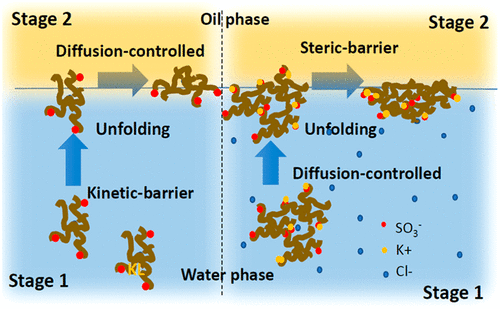Our official English website, www.x-mol.net, welcomes your
feedback! (Note: you will need to create a separate account there.)
Interfacial and Emulsion Characteristics of Oil–Water Systems in the Presence of Polymeric Lignin Surfactant
Langmuir ( IF 3.7 ) Pub Date : 2021-03-05 , DOI: 10.1021/acs.langmuir.0c03458 Nasim Ghavidel 1 , Pedram Fatehi 1
Langmuir ( IF 3.7 ) Pub Date : 2021-03-05 , DOI: 10.1021/acs.langmuir.0c03458 Nasim Ghavidel 1 , Pedram Fatehi 1
Affiliation

|
It is hypothesized that polymeric lignin surfactants have different affinities for stabilizing oil–water emulsions and that the emulsifying performance of these surfactants is highly affected by their adsorption performance at the oil–water interface. To validate this hypothesis, the adsorption performance of sulfethylated lignin (SEKL) surfactant at different oil–water interfaces was examined by assessing the contact angle, dynamic interfacial tension, and surface loading (Γ). Moreover, the interfacial adsorption kinetics of SEKL was comprehensively assessed in different oil–water systems to reveal the mechanisms of the SEKL adsorption at the interface. Also, the impacts of SEKL concentration and ionic strength on the performance of SEKL as an effective emulsifier for the emulsions were assessed. Furthermore, the droplet size and instability index of the emulsions were systematically correlated with the adsorption performance of SEKL at the interface of oil and water. For the first time, by implementing a modified Ward Toradai diffusion model, two distinct early stages of the adsorption of SEKL at the oil interface were identified. Interestingly, the second stage was the determining stage of adsorption with the diffusion-controlled mechanism when polymers reconfigured at the oil–water interface. Salt screening facilitated the clustering of SEKL upon charge repulsion elimination, which removed the energy barrier in the first stage of adsorption (ΔEp→0 = 0), but it introduced a steric barrier upon the reconfiguration of polymers at the oil interfaces in the second stage of adsorption. In addition to the kinetics of adsorption, satisfactory correlations were observed between surface pressure (Δγ = γ∞ – γ0), surface loading (Γ) of polymers, and contact angle at oil interfaces on one hand and the oil droplet size and emulsion stability on the other hand.
中文翻译:

聚合木质素表面活性剂存在下油水系统的界面和乳液特性
据推测,聚合木质素表面活性剂对稳定油水乳液具有不同的亲和力,并且这些表面活性剂的乳化性能受到其在油水界面的吸附性能的高度影响。为了验证该假设,通过评估接触角,动态界面张力和表面载荷(Γ)检验了磺乙基化木质素(SEKL)表面活性剂在不同油水界面的吸附性能。此外,在不同的油水系统中对SEKL的界面吸附动力学进行了全面评估,以揭示SEKL在界面处的吸附机理。此外,评估了SEKL浓度和离子强度对SEKL作为乳液有效乳化剂的性能的影响。此外,乳液的液滴尺寸和不稳定性指数与SEKL在油和水界面的吸附性能系统地相关。首次通过实施改进的Ward Toradai扩散模型,确定了SEKL在油界面处的吸附的两个不同的早期阶段。有趣的是,第二阶段是当聚合物在油水界面重新配置时,采用扩散控制机制进行吸附的确定阶段。盐筛选有助于消除电荷排斥后SEKL的聚集,从而消除了吸附第一阶段的能垒(Δ 确定了SEKL在油界面上吸附的两个不同的早期阶段。有趣的是,第二阶段是当聚合物在油水界面重新配置时,采用扩散控制机制进行吸附的确定阶段。盐筛选有助于消除电荷排斥后SEKL的聚集,从而消除了吸附第一阶段的能垒(Δ 确定了SEKL在油界面上吸附的两个不同的早期阶段。有趣的是,第二阶段是当聚合物在油水界面重新配置时,采用扩散控制机制进行吸附的确定阶段。盐筛选有助于消除电荷排斥后SEKL的聚集,从而消除了吸附第一阶段的能垒(ΔE p →0 = 0),但是它在第二阶段吸附过程中在油界面处的聚合物重新构型时引入了空间位阻。除了吸附的动力学,进行了表面压力(Δγ=γ之间观察到令人满意的相关性∞ - γ 0)的聚合物,表面负荷(Γ),和接触角在油界面一方面和油滴大小和乳化稳定性另一方面。
更新日期:2021-03-23
中文翻译:

聚合木质素表面活性剂存在下油水系统的界面和乳液特性
据推测,聚合木质素表面活性剂对稳定油水乳液具有不同的亲和力,并且这些表面活性剂的乳化性能受到其在油水界面的吸附性能的高度影响。为了验证该假设,通过评估接触角,动态界面张力和表面载荷(Γ)检验了磺乙基化木质素(SEKL)表面活性剂在不同油水界面的吸附性能。此外,在不同的油水系统中对SEKL的界面吸附动力学进行了全面评估,以揭示SEKL在界面处的吸附机理。此外,评估了SEKL浓度和离子强度对SEKL作为乳液有效乳化剂的性能的影响。此外,乳液的液滴尺寸和不稳定性指数与SEKL在油和水界面的吸附性能系统地相关。首次通过实施改进的Ward Toradai扩散模型,确定了SEKL在油界面处的吸附的两个不同的早期阶段。有趣的是,第二阶段是当聚合物在油水界面重新配置时,采用扩散控制机制进行吸附的确定阶段。盐筛选有助于消除电荷排斥后SEKL的聚集,从而消除了吸附第一阶段的能垒(Δ 确定了SEKL在油界面上吸附的两个不同的早期阶段。有趣的是,第二阶段是当聚合物在油水界面重新配置时,采用扩散控制机制进行吸附的确定阶段。盐筛选有助于消除电荷排斥后SEKL的聚集,从而消除了吸附第一阶段的能垒(Δ 确定了SEKL在油界面上吸附的两个不同的早期阶段。有趣的是,第二阶段是当聚合物在油水界面重新配置时,采用扩散控制机制进行吸附的确定阶段。盐筛选有助于消除电荷排斥后SEKL的聚集,从而消除了吸附第一阶段的能垒(ΔE p →0 = 0),但是它在第二阶段吸附过程中在油界面处的聚合物重新构型时引入了空间位阻。除了吸附的动力学,进行了表面压力(Δγ=γ之间观察到令人满意的相关性∞ - γ 0)的聚合物,表面负荷(Γ),和接触角在油界面一方面和油滴大小和乳化稳定性另一方面。











































 京公网安备 11010802027423号
京公网安备 11010802027423号